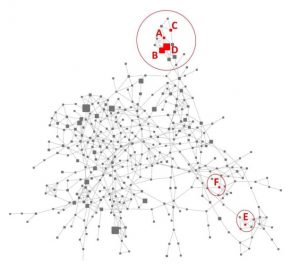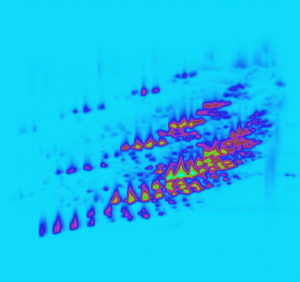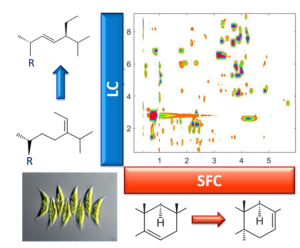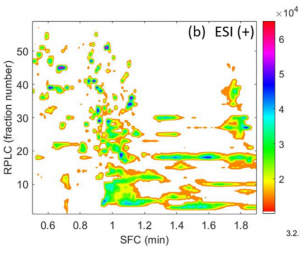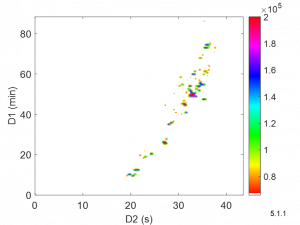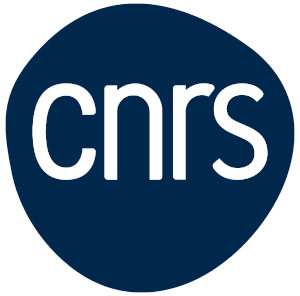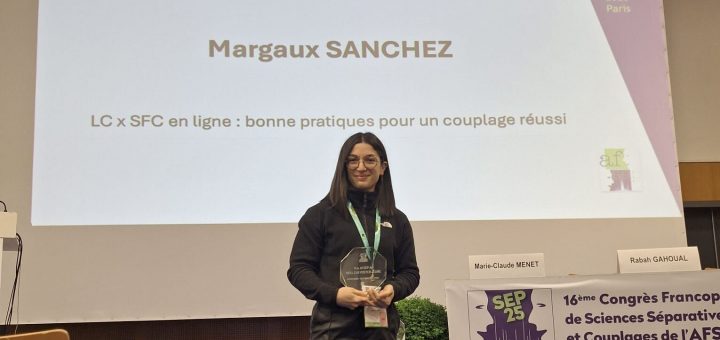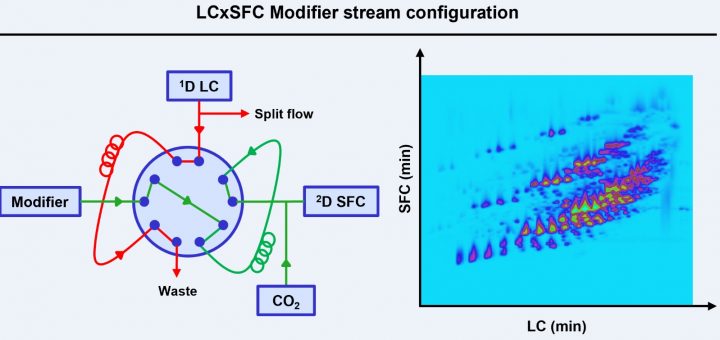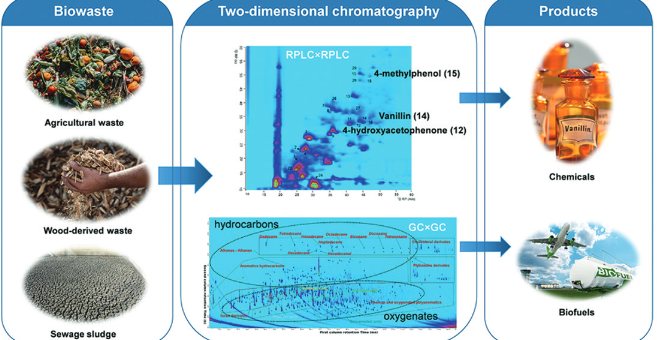Introduction
L’équipe focalise ses recherches sur l’amélioration des techniques chromatographiques multidimensionnelles en vue de dépasser les performances des séparations effectuées par chromatographie liquide. Les sujets d’étude sont par conséquence dictés par les limites à dépasser: analyses non ciblées de mélanges complexes (> 500 molécules), résolution des isobares, isomères ou molécules structurellement proches pour lesquelles les approches LC-MS/MS sont peu résolutives…
La chromatographie bidimensionnelle LCxLC est une technique en pleine croissance, proposant pour les composés ionisables de très grandes capacités de pics et de fortes orthogonalités. Des développements méthodologiques restent cependant à apporter sur les couplages « délicats » tels que la HILIC et la RPLC pour les composés polaires (dont les sucres). Enfin, les composés neutres qui diagonalisent en LCxLC peuvent nécessiter la mise en œuvre de méthodes originales comme les gradients parallèles, pour lesquelles la compréhension des comportements à l’élution des molécules reste à élucider.
L’équipe cherche également à innover, en proposant un travail de recherche sur le couplage en ligne LCxSFC. La SFC (chromatographie en fluide supercritique) génère des interactions très différentes de celles obtenues en LC et la combinaison des deux techniques présente un intérêt résolutif certain, reconnu par la communauté scientifique. Ce couplage n’existant pas commercialement, toutes les facettes restent à explorer, depuis les développements instrumentaux (prototype, nouvelles interfaces, développements en lien avec les sociétés d’instrumentation), l’étude de l’orthogonalité (sélectivité des colonnes et choix raisonné des combinaisons) et mise en évidence du potentiel à résoudre les isomères par couplage LCxSFC-MS/MS (réalisé hors ligne) jusqu’à l’application pour l’analyse non ciblée sur matrices complexes.
Enfin, tous les nouveaux développements et méthodologies proposées doivent se confronter à des échantillons réels, complexes et d’intérêt. Nous avons identifiés deux grands axes d’application, à savoir l’amélioration des procédés industriels (et notamment l’impact de l’usage des matières biosourcées et/ou recyclées) et la caractérisation de la biomasse et des déchets organiques en vue de leur valorisation.
Axes de recherche
Projets de recherche
BIOPOLIOL: Caractérisation par LCxSFC-MS/MS d’oligomères de lignine dépolymérisée
ONLINE! : Conception d’un instrument LCxSFC en ligne
LIPS: Caractérisation par LCxSFC-MS/MS de phytostérols dans les microalgues
RafBioAlg: Caractérisation par LCxSFC-HRMS d’eaux usées recyclées
EAQ-2D : Séparer des isomères et homologues neutres en contexte industriel
HA-R: Utiliser le mode HILIC en seconde dimension pour l’analyse de polysaccharides
Capacités expérimentales et instrumentales
Chaînes LC avec collecteur de fraction : 1260 Infinity II (Agilent) ; Acquity UPLC I-Class (Waters)
Chaînes LCxLC : 1290 Infinity (Agilent) ; 1290 Infinity II (Agilent) ; Acquity UPLC I-Class (Waters)
Chaînes SFC : 1260 Infinity II (Agilent) ; Acquity UPC² (Waters)
Spectromètres de masse : Acquity QDA (Waters) ; Infinity Lab LC/MSD (Agilent) ; 6560 Ion Mobility Q-TOF LC/MS (Agilent)
Personnels
Chercheurs et enseignants-chercheurs
Soutien à la recherche
Doctorants
Publications (sources HAL)
Articles dans une revue
- Jason Devaux, Mélanie Mignot, Morgan Sarrut, Guillaume Limousin, Carlos Afonso, et al.. Optimizing conditions in online RPLC × SFC for the analysis of complex samples containing neutral compounds: Solving injection issues. Journal of Chromatography A, 2025, 1739, pp.465518. ?10.1016/j.chroma.2024.465518?. ?hal-04911181?
- Eliise Tammekivi, Karine Faure. Formation of artifacts from simple phenolic compounds in SFC-UV-(HR)MS. Analytical Chemistry, 2025, 97 (8), pp.4481-4489. ?10.1021/acs.analchem.4c05941?. ?hal-04995764?
- Clémence Giffard, Florent Rouvière, Olivier Falletti, Béatrice Allard-Breton, Laurent Wendlinger, et al.. Analysis of alkyl-anthraquinone derivatives from hydrogen peroxide industrial process, using LC×LC-HRMS with shifting gradients. Analytical Methods, 2025, ?10.1039/d4ay01905a?. ?hal-04868106?
- Jason Devaux, Caroline Barrère-Mangote, Pierre Giusti, Sabine Heinisch, Carlos Afonso, et al.. Online Supercritical Fluid Chromatography Hyphenated to Fourier Transform Ion Cyclotron Resonance Mass Spectrometry with Quadrupole Detection for Microalgae Bio-Oil Characterization. Analytical Chemistry, 2024, ?10.1021/acs.analchem.4c01779?. ?hal-04911177?
- Anaïs George, Isabelle Schmitz, Florent Rouvière, Sandra Alves, Benoit Colsch, et al.. Interplatform comparison between three ion mobility techniques for human plasma lipid collision cross sections. Analytica Chimica Acta, 2024, 1304, pp.342535. ?10.1016/j.aca.2024.342535?. ?hal-04617221?
- Megane Aebischer, Soraya Chapel, Davy Guillarme, Sabine Heinisch. Theoretical and practical guidelines for solvent dilution between the two dimensions in online comprehensive two-dimensional liquid chromatography. Journal of Chromatography A, 2024, 1718, pp.464725. ?10.1016/j.chroma.2024.464725?. ?hal-04617210?
- Eliise Tammekivi, Magali Batteau, Dorothée Laurenti, Hugo Lilti, Karine Faure. A powerful two-dimensional chromatography method for the non-target analysis of depolymerised lignin. Analytica Chimica Acta, 2024, 1288, pp.342157. ?10.1016/j.aca.2023.342157?. ?hal-04396928?
- Eliise Tammekivi, Hugo Lilti, Magali Batteau, Chantal Lorentz, Christophe Geantet, et al.. Complementarity of two-dimensional gas chromatography and two-dimensional liquid chromatography for the analysis of depolymerised l. Journal of Chromatography A, 2024, 1736, pp.465401. ?10.1016/j.chroma.2024.465401?. ?hal-04727323?
- Magali Batteau, Adriana Ramirez-Romero, Elodie Bouju, Sylvie Nuccio, René de Vaumas, et al.. Resolving phytosterols in microalgae using offline two-dimensional reversed phase liquid chromatography × supercritical fluid chromatography coupled to quadrupole time-of-flight mass spectrometry. Analytical Methods, 2024, 16, pp.2278-2285. ?10.1039/D3AY02261G?. ?hal-04493944?
- Clémence Gély, Yoan Monneau, Maggy Hologne, Karine Faure. Impact of conditioning runs on hydrophilic interaction chromatography repeatability and its application as a second dimension in online comprehensive two-dimensional liquid chromatography. Journal of Separation Science, 2024, 47, ?10.1002/jssc.202300935?. ?hal-04590635?
- Margaux Sanchez, Oscar Lacroix-Andrivet, Delphine Crozet, Julien Crepier, Karine Faure. Structural elucidation of complex polyesters polyols from bio-lubricant using off-line liquid chromatography x supercritical fluid chromatography coupled with Orbitrap mass spectrometry. Talanta, 2024, 276, pp.126295. ?10.1016/j.talanta.2024.126295?. ?hal-04617064?
- Margaux Sanchez, Florent Rouvière, Julien Crepier, Karine Faure. LCxSFC valve technologies: guidelines towards a successful on-line modulation. Analytical Chemistry, 2024, 276 (39), pp.126295. ?10.1021/acs.analchem.4c03263?. ?hal-04727276?
- Daniel Armstrong, Alain Berthod. Occurrence of D-amino acids in natural products. Natural Products and Bioprospecting, 2023, 13 (1), pp.47. ?10.1007/s13659-023-00412-0?. ?hal-04617120?
- Eliise Tammekivi, Christophe Geantet, Chantal Lorentz, Karine Faure. Two-dimensional chromatography for the analysis of valorisable biowaste: A review. Analytica Chimica Acta, 2023, pp.341855. ?10.1016/j.aca.2023.341855?. ?hal-04240342?
- Soraya Chapel, Florent Rouvière, Davy Guillarme, Sabine Heinisch. Reversed HILIC Gradient: A Powerful Strategy for On-Line Comprehensive 2D-LC. Molecules, 2023, 28 (9), pp.3907. ?10.3390/molecules28093907?. ?hal-04617228?
- Jason Devaux, Mélanie Mignot, Florent Rouvière, Isabelle François, Carlos Afonso, et al.. On-line reversed-phase liquid chromatography x supercritical fluid chromatography coupled to high-resolution mass spectrometry: A powerful tool for the characterization of advanced biofuels. Journal of Chromatography A, 2023, 1697, pp.463964. ?10.1016/j.chroma.2023.463964?. ?hal-04070590?
- Jauh Tzuoh Lee, Alain Berthod, Daniel Armstrong. Comparison of core‐shell versus fully porous particle packings for chiral liquid chromatography productivity. Journal of Separation Science, 2023, 46 (8), ?10.1002/jssc.202200738?. ?hal-04617124?
- Eloïse Teboul, Eliise Tammekivi, Magali Batteau, Christophe Geantet, Karine Faure. Off-line two-dimensional separation involving supercritical fluid chromatography for the characterization of the wastewater from algae hydrothermal liquefaction. Journal of Chromatography A, 2023, 1694, pp.463907. ?10.1016/j.chroma.2023.463907?. ?hal-04037993?
- Soraya Chapel, Florent Rouvière, Sabine Heinisch. Sense and nonsense of shifting gradients in on-line comprehensive reversed-phase LC × reversed-phase LC. Journal of Chromatography B - Analytical Technologies in the Biomedical and Life Sciences, 2022, 1212, pp.123512. ?10.1016/j.jchromb.2022.123512?. ?hal-04617200?
- Davy Guillarme, Florent Rouvière, Sabine Heinisch. Theoretical and practical comparison of RPLC and RPLC × RPLC: how to consider dilution effects and sensitivity in addition to separation power?. Analytical and Bioanalytical Chemistry, 2022, 415 (13), pp.2357-2369. ?10.1007/s00216-022-04385-w?. ?hal-04911146?
- Saba Aslani, M. Farooq Wahab, Marziyeh Eshaghi Kenari, Alain Berthod, Daniel Armstrong. An examination of the effects of water on normal phase enantioseparations. Analytica Chimica Acta, 2022, 1200, pp.339608. ?10.1016/j.aca.2022.339608?. ?hal-04617129?
- Soraya Chapel, Florent Rouvière, Pierre Guibal, Delphine Mathieu, Sabine Heinisch. Development of a sub-hour on-line comprehensive cation exchange chromatography x RPLC method hyphenated to HRMS for the characterization of lysine-linked antibody-drug conjugates. Talanta, 2022, 240, pp.123174. ?10.1016/j.talanta.2021.123174?. ?hal-03615542?
- Saba Aslani, M. Farooq Wahab, Marziyeh Eshaghi Kenari, Alain Berthod, Daniel Armstrong. An examination of the effects of water on normal phase enantioseparations. Analytica Chimica Acta, 2022, 1200, pp.339608. ?10.1016/j.aca.2022.339608?. ?hal-03702889?
- Sepideh Khaki Firooz, Joshua Putman, Brandon Fulton, Carl Lovely, Alain Berthod, et al.. Liquid chromatography enantiomeric separation of chiral ethanolamine substituted compounds. Chirality, 2022, 34 (4), pp.620-629. ?10.1002/chir.23419?. ?hal-04617133?
- Fleur Marie Saint Germain, Karine Faure, Estelle Saunier, Jean-Michel Lerestif, Sabine Heinisch. On-line 2D-RPLC x RPLC – HRMS to assess wastewater treatment in a pharmaceutical plant. Journal of Pharmaceutical and Biomedical Analysis, 2022, 208, pp.114465. ?10.1016/j.jpba.2021.114465?. ?hal-03823578?
- Davy Guillarme, Thomas Bouvarel, Florent Rouvière, Sabine Heinisch. A simple mathematical treatment for predicting linear solvent strength behavior in gradient elution: Application to biomolecules. Journal of Separation Science, 2022, ?10.1002/jssc.202200161?. ?hal-03702882?
- Magali Batteau, Karine Faure. Effect of the injection of water-containing diluents on band broadening in analytical supercritical fluid chromatography. Journal of Chromatography A, 2022, 1673, pp.463056. ?10.1016/j.chroma.2022.463056?. ?hal-03711565?
- Soraya Chapel, Sabine Heinisch. Strategies to circumvent the solvent strength mismatch problem in online comprehensive two‐dimensional liquid chromatography. Journal of Separation Science, 2022, 45 (1), pp.7-26. ?10.1002/jssc.202100534?. ?hal-03369590?
- Sepideh Khaki Firooz, Joshua Putman, Brandon Fulton, Carl Lovely, Alain Berthod, et al.. Liquid chromatography enantiomeric separation of chiral ethanolamine substituted compounds. Chirality, 2022, pp.early access. ?10.1002/chir.23419?. ?hal-03554461?
- Marion Burlet-Parendel, Karine Faure. Opportunities and challenges of liquid chromatography coupled to supercritical fluid chromatography. Trends in Analytical Chemistry, 2021, 144, pp.116422. ?10.1016/j.trac.2021.116422?. ?hal-03326884?
- Amandine Dispas, Adrian Clarke, Alexandre Grand-Guillaume Perrenoud, Luca Gioacchino Losacco, Jean-Luc Veuthey, et al.. Interlaboratory study of a supercritical fluid chromatography method for the determination of pharmaceutical impurities: Evaluation of multi-systems reproducibility. Journal of Pharmaceutical and Biomedical Analysis, 2021, 203, pp.114206. ?10.1016/j.jpba.2021.114206?. ?hal-03322675?
- Soraya Chapel, Florent Rouvière, Vincent Peppermans, Gert Desmet, Sabine Heinisch. A comprehensive study on the phenomenon of total breakthrough in liquid chromatography. Journal of Chromatography A, 2021, 1653, pp.462399. ?10.1016/j.chroma.2021.462399?. ?hal-03324142?
- Lucile Lecas, Sylvie Nuccio, René Vaumas, Karine Faure. Off‐line two‐dimensional liquid chromatography separation for the quality control of saponins samples from Quillaja Saponaria. Journal of Separation Science, 2021, 44 (16), pp.3070- 3079. ?10.1002/jssc.202100115?. ?hal-03317997?
- Julien Crépier, Estelle Corbel, Jean-Michel Lerestif, Alain Berthod, Sabine Heinisch. Characterization of positional isomers of drug intermediates by off-line RPLC x SFC hyphenated to high resolution MS. Journal of Pharmaceutical and Biomedical Analysis, 2021, 202, pp.114142. ?10.1016/j.jpba.2021.114142?. ?hal-03318444?
- Yu-Sheng Sung, Alain Berthod, Daipayan Roy, Daniel Armstrong. A Closer Examination of 6-Aminoquinolyl-N-Hydroxysuccinimidyl Carbamate Amino Acid Derivatization in HPLC with Multiple Detection Modes. Chromatographia, 2021, 84 (8), pp.719-727. ?10.1007/s10337-021-04051-w?. ?hal-04617143?
- Soraya Chapel, Florent Rouvière, Sabine Heinisch. Comparison of existing strategies for keeping symmetrical peaks in on-line Hydrophilic Interaction Liquid Chromatography x Reversed-Phase Liquid Chromatography despite solvent strength mismatch. Journal of Chromatography A, 2021, 1642, pp.462001. ?10.1016/j.chroma.2021.462001?. ?hal-03318522?
- Vincent Pepermans, Soraya Chapel, Sabine Heinisch, Gert Desmet. Detailed numerical study of the peak shapes of neutral analytes injected at high solvent strength in short reversed-phase liquid chromatography columns and comparison with experimental observations. Journal of Chromatography A, 2021, 1643, pp.462078. ?10.1016/j.chroma.2021.462078?. ?hal-03208629?
- Marziyeh Kenari, Joshua Putman, Ravi Singh, Brandon Fulton, Huy Phan, et al.. Enantiomeric Separation of New Chiral Azole Compounds. Molecules, 2021, 26 (1), pp.213. ?10.3390/molecules26010213?. ?hal-04617149?
- S. Adekenov, I. Khabarov, G. Yakovenko, A. Adekenova, Alain Berthod. Modeling and Optimization of Chromatographic Purification of Arglabin from CO2 Extract of Artemisia glabella Kar. et Kir.. Chromatographia, 2021, 84 (1077-1086), ?10.1007/s10337-021-04093-0?. ?hal-03352280?
- Marziyeh E Kenari, Joshua I Putman, Ravi P Singh, Brandon B Fulton, Huy Phan, et al.. Enantiomeric Separation of New Chiral Azole Compounds. Molecules, 2021, 26 (1), pp.213. ?10.3390/molecules26010213?. ?hal-03318473?
- Léa Marlot, Magali Batteau, Karine Faure. Classification of biphasic solvent systems according to Abraham descriptors for countercurrent chromatography. Journal of Chromatography A, 2020, 1617, pp.460820. ?10.1016/j.chroma.2019.460820?. ?hal-02436965?
- Soraya Chapel, Florent Rouvière, Sabine Heinisch. Pushing the limits of resolving power and analysis time in on-line comprehensive hydrophilic interaction x reversed phase liquid chromatography for the analysis of complex peptide samples. Journal of Chromatography A, 2020, 1615, pp.460753. ?10.1016/j.chroma.2019.460753?. ?hal-02433592?
- Marie Bernardin, Agnès Le Masle, Frédérique Bessueille-Barbier, Charles-Philippe Lienemann, Sabine Heinisch. Comprehensive two-dimensional liquid chromatography with inductively coupled plasma mass spectrometry detection for the characterization of sulfur, vanadium and nickel compounds in petroleum products. Journal of Chromatography A, 2020, 1611, pp.460605. ?10.1016/j.chroma.2019.460605?. ?hal-02442806?
- Luca Pompermaier, Stefan Schwaiger, Monizi Mawunu, Thea Lautenschlaeger, Hermann Stuppner, et al.. Purification of thonningianins A and B and four further derivatives from Thonningia sanguinea by one‐ and two‐dimensional centrifugal partition chromatography. Journal of Separation Science, 2020, 43 (2), pp.524-530. ?10.1002/jssc.201900811?. ?hal-02338304?
- Siqi Du, Yu-Sheng Sung, Michael Wey, Yadi Wang, Nagham Alatrash, et al.. Roles of N-methyl-d-aspartate receptors and d-amino acids in cancer cell viability. Molecular Biology Reports, 2020, 47, pp.6749-6758. ?10.1007/s11033-020-05733-8?. ?hal-02946426?
- M. Farooq Wahab, Alain Berthod, Daniel Armstrong. Extending the power transform approach for recovering areas of overlapping peaks. Journal of Separation Science, 2019, 42 (24), pp.3604-3610. ?10.1002/jssc.201900799?. ?hal-02439726?
- Marie Bernardin, Frédérique Bessueille-Barbier, Agnès Le Masle, Charles-Philippe Lienemann, Sabine Heinisch. Suitable interface for coupling liquid chromatography to inductively coupled plasma-mass spectrometry for the analysis of organic matrices. 2 Comparison of Sample Introduction Systems. Journal of Chromatography A, 2019, 1603, pp.380-387. ?10.1016/j.chroma.2019.04.074?. ?hal-02162840?
- Marion Iguiniz, Estelle Corbel, Nicolas Roques, Sabine Heinisch. Quantitative aspects in on-line comprehensive two-dimensional liquid chromatography for pharmaceutical applications. Talanta, 2019, 195, pp.272-280. ?10.1016/j.talanta.2018.11.030?. ?hal-02014687?
- Lucile Lecas, Jérôme Randon, Alain Berthod, Vincent Dugas, Claire Demesmay. Monolith weak affinity chromatography for μg-protein-ligand interaction study. Journal of Pharmaceutical and Biomedical Analysis, 2019, 166, pp.164-173. ?10.1016/j.jpba.2019.01.012?. ?hal-02015987?
- Anthony Ehkirch, Alexandre Goyon, Oscar Hernandez-Alba, Florent Rouvière, Valentina D’atri, et al.. A Novel Online Four-Dimensional SEC×SEC-IM×MS Methodology for Characterization of Monoclonal Antibody Size Variants. Analytical Chemistry, 2018, 90 (23), pp.13929-13937. ?10.1021/acs.analchem.8b03333?. ?hal-02060860?
- Mohsen Talebi, Rahul Patil, Leonard Sidisky, Alain Berthod, Daniel Armstrong. Variation of anionic moieties of dicationic ionic liquid GC stationary phases: Effect on stability and selectivity. Analytica Chimica Acta, 2018, 1042, pp.155-164. ?10.1016/j.aca.2018.07.047?. ?hal-01933471?
- Léa Marlot, Magali Batteau, Dalene de Beer, Karine Faure. In silico screening of comprehensive two-dimensional centrifugal partition chromatography x liquid chromatography for multiple compounds isolation. Analytical Chemistry, 2018, 90 (24), pp.14279-14286. ?10.1021/acs.analchem.8b03440?. ?hal-01937324?
- Amandine Dispas, Roland Marini, Vincent Desfontaine, Jean-Luc Veuthey, Dorina Kotoni, et al.. First inter-laboratory study of a Supercritical Fluid Chromatography method for the determination of pharmaceutical impurities. Journal of Pharmaceutical and Biomedical Analysis, 2018, 161, pp.414-424. ?10.1016/j.jpba.2018.08.042?. ?hal-01911400?
- Rahul Patil, Mohsen Talebi, Leonard Sidisky, Alain Berthod, Daniel Armstrong. Gas chromatography selectivity of new phosphonium-based dicationic ionic liquid stationary phases. Journal of Separation Science, 2018, 41 (22), pp.4142-4148. ?10.1002/jssc.201800695?. ?hal-02016014?
- Hongyue Guo, M. Farooq Wahab, Alain Berthod, Daniel Armstrong. Mass spectrometry detection of basic drugs in fast chiral analyses with vancomycin stationary phases. Journal of Pharmaceutical Analysis, 2018, 8 (5), pp.324-332. ?10.1016/j.jpha.2018.08.001?. ?hal-01936927?
- Garrett Hellinghausen, Diego A. Lopez, Jauh Lee, Yadi Wang, Choyce Weatherly, et al.. Evaluation of the Edman degradation product of vancomycin bonded to core-shell particles as a new HPLC chiral stationary phase. Chirality, 2018, 30 (9), pp.1067-1078. ?10.1002/chir.22985?. ?hal-02016053?
- Marion Iguiniz, Estelle Corbel, Nicolas Roques, Sabine Heinisch. On-line coupling of achiral Reversed Phase Liquid Chromatography and chiral Supercritical Fluid Chromatography for the analysis of pharmaceutical compounds. Journal of Pharmaceutical and Biomedical Analysis, 2018, 159, pp.237-244. ?10.1016/j.jpba.2018.06.058?. ?hal-01900240?
- Marie Bernardin, Frédérique Bessueille-Barbier, Agnès Le Masle, Charles-Philippe Lienemann, Sabine Heinisch. Suitable interface for coupling liquid chromatography to inductively coupled plasma-mass spectrometry for the analysis of organic matrices. 1 Theoretical and experimental considerations on solute dispersion. Journal of Chromatography A, 2018, 1565, pp.68-80. ?10.1016/j.chroma.2018.06.024?. ?hal-01858414?
- Léa Marlot, Magali Batteau, Karine Faure. Comparison between centrifugal partition chromatography and preparative liquid chromatography as first dimensions in off-line two-dimensional separation: Application to the isolation of multi-targeted compounds from Edelweiss plant. Electrophoresis, 2018, 39 (15), pp.2011-2019. ?10.1002/elps.201800032?. ?hal-01809502?
- Alain Berthod, M.J. Ruiz-Ángel, S. Carda-Broch. Recent advances on ionic liquid uses in separation techniques. Journal of Chromatography A, 2018, 1559, pp.2-16. ?10.1016/j.chroma.2017.09.044?. ?hal-01825252?
- Rahul A Patil, Mohsen Talebi, Alain Berthod, Daniel W Armstrong. Dicationic ionic liquid thermal decomposition pathways. Analytical and Bioanalytical Chemistry, 2018, 410 (19), pp.4645-4655. ?10.1007/s00216-018-0878-0?. ?hal-01858978?
- Mohsen Talebi, Rahul A Patil, Leonard Sidisky, Alain Berthod, Daniel W Armstrong. Branched-chain dicationic ionic liquids for fatty acid methyl ester assessment by gas chromatography. Analytical and Bioanalytical Chemistry, 2018, 410 (19), pp.4633-4643. ?10.1007/s00216-017-0722-y?. ?hal-01858986?
- Davy Guillarme, Vincent Desfontaine, Sabine Heinisch, Jean-Luc Veuthey. What are the current solutions for interfacing supercritical fluid chromatography and mass spectrometry?. Journal of Chromatography B - Analytical Technologies in the Biomedical and Life Sciences, 2018, 1083, pp.160-170. ?10.1016/j.jchromb.2018.03.010?. ?hal-01744682?
- Marion Iguiniz, Florent Rouvière, Estelle Corbel, Nicolas Roques, Sabine Heinisch. Comprehensive two dimensional liquid chromatography as analytical strategy for pharmaceutical analysis. Journal of Chromatography A, 2018, 1536, pp.195-204. ?10.1016/j.chroma.2017.08.070?. ?hal-01580276?
- José Cheel, Jan Hájek, Marek Kuzma, Kumar Saurav, Iva Smykalova, et al.. Application of HPCCC Combined with Polymeric Resins and HPLC for the Separation of Cyclic Lipopeptides Muscotoxins A–C and Their Antimicrobial Activity. Molecules, 2018, 23 (10), pp.2653. ?10.3390/molecules23102653?. ?hal-01963293?
- Julien Crepier, Agnès Le Masle, Nadège Charon, Florian Albrieux, Pascal Duchêne, et al.. Ultra-high performance supercritical fluid chromatography hyphenated to atmospheric pressure chemical ionization high resolution mass spectrometry for the characterization of fast pyrolysis bio-oils. Journal of Chromatography B - Analytical Technologies in the Biomedical and Life Sciences, 2018, 1086, pp.38-46. ?10.1016/j.jchromb.2018.04.005?. ?hal-01803300?
- Anthony Ehkirch, Valentina d'Atri, Florent Rouvière, Oscar Hernandez-Alba, Alexandre Goyon, et al.. An Online Four-Dimensional HIC×SEC-IM×MS Methodology for Proof-of-Concept Characterization of Antibody Drug Conjugates. Analytical Chemistry, 2018, 90 (3), pp.1578 - 1586. ?10.1021/acs.analchem.7b02110?. ?hal-01767719?
- Alain Berthod. Separation and Purification with a Liquid Stationary Phase. Separations, 2017, 4 (4), pp.article number: 30. ?10.3390/separations4040030?. ?hal-01687013?
- Darshan Patel, Ross M. Woods, Zachary S. Breitbach, Alain Berthod, Daniel W. Armstrong. Thermal racemization of biaryl atropisomers. Tetrahedron: Asymmetry, 2017, 28 (11), pp.1557 - 1561. ?10.1016/j.tetasy.2017.09.006?. ?hal-01682292?
- Deirdre Cabooter, Paul Ferguson, Sebastiaan Eeltink, Frederic Lynen, Sabine Heinisch. LC Instrumentation: The State of the Art . LC GC Europe, 2017, 30 (11), pp.600-604. ?hal-01682161?
- Marion Iguiniz, Sabine Heinisch. Two-dimensional liquid chromatography in pharmaceutical analysis. Instrumental aspects, trends and applications. Journal of Pharmaceutical and Biomedical Analysis, 2017, 145, pp.482-503. ?10.1016/j.jpba.2017.07.009?. ?hal-01575228?
- Léa Marlot, Magali Batteau, Marie-Claire Escofet, Sylvie Nuccio, Véronique Coquoin, et al.. Two-dimensional multi-heart cutting centrifugal partition chromatography–liquid chromatography for the preparative isolation of antioxidants from Edelweiss plant. Journal of Chromatography A, 2017, 1504, pp.55-63. ?10.1016/j.chroma.2017.04.056?. ?hal-01569418?
- Morgan Sarrut, Florent Rouvière, Sabine Heinisch. Theoretical and experimental comparison of one dimensional versus on-line comprehensive two dimensional liquid chromatography for optimized sub-hour separations of complex peptide samples . Journal of Chromatography A, 2017, 1498, pp.183-195. ?10.1016/j.chroma.2017.01.054?. ?hal-01539812?
- Fériel Bouiche, Karine Faure. In-situ protein determination to monitor contamination in a centrifugal partition chromatograph. Analytical Biochemistry, 2017, 525, pp.23-28. ?10.1016/j.ab.2017.02.015?. ?hal-01518929?
- Léa Marlot, Karine Faure. Preparative two dimensional separations involving liquid–liquid chromatography. Journal of Chromatography A, 2017, 1494, pp.1-17. ?10.1016/j.chroma.2017.03.031?. ?hal-01515553?
- Josiane Saadé, Nina Declas, Pedro Marote, Claire Bordes, Karine Faure. Functionalization of cyclic olefin copolymer substrates with polyethylene glycol diacrylate for the in situ synthesis of immobilized nanoparticles. Journal of Materials Science, 2017, 52 (8), pp.4509-4520. ?10.1007/s10853-016-0696-8?. ?hal-01515322?
- José Cheel, Petra Urajová, Jan Hájek, Pavel Hrouzek, Marek Kuzma, et al.. Separation of cyclic lipopeptides puwainaphycins from cyanobacteria by HPCCC combined with polymeric resins and HPLC. Analytical and Bioanalytical Chemistry, 2017, 409 (4), pp.917-930. ?10.1007/s00216-016-0066-z?. ?hal-01515308?
- Julien Crepier, Agnès Le Masle, Nadège Charon, Florian Albrieux, Sabine Heinisch. Development of a supercritical fluid chromatography method with ultraviolet and mass spectrometry detection for the characterization of biomass fast pyrolysis bio oils. Journal of Chromatography A, 2017, 1510, pp.73-81. ?10.1016/j.chroma.2017.06.003?. ?hal-01574810?
- Yeeun Lim, Zachary S. Breitbach, Daniel W. Armstrong, Alain Berthod. Screening primary racemic amines for enantioseparation by derivatized polysaccharide and cyclofructan columns. Journal of Pharmaceutical Analysis, 2016, 6 (6), pp.345-355. ?10.1016/j.jpha.2016.07.003?. ?hal-01546508?
- Norbert Fumat, Alain Berthod, Karine Faure. Effect of operating parameters on a centrifugal partition chromatography separation. Journal of Chromatography A, 2016, 1474, pp.47-58. ?10.1016/j.chroma.2016.10.014?. ?hal-01515264?
- Morgan Sarrut, Szabolcs Fekete, Marie-Claire Janin-Bussat, Olivier Colas, Davy Guillarme, et al.. Analysis of antibody-drug conjugates by comprehensive on-line two-dimensional hydrophobic interaction chromatography x reversed phase liquid chromatography hyphenated to high resolution mass spectrometry. II- Identification of sub-units for the characterization of even and odd load drug species. Journal of Chromatography B - Analytical Technologies in the Biomedical and Life Sciences, 2016, 1032, pp.91-102. ?10.1016/j.jchromb.2016.06.049?. ?hal-02060879?
- Elodie Bouju, Alain Berthod, Karine Faure. Carnosol purification. Scaling-up centrifugal partition chromatography separations. Journal of Chromatography A, 2016, 1466, pp.59-66. ?10.1016/j.chroma.2016.08.015?. ?hal-01515260?
- Zachary Breitbach, Alain Berthod, Ke Huang, Daniel Armstrong. Mass spectrometric detection of trace anions: The evolution of paired-ion electrospray ionization (PIESI). Mass Spectrometry Reviews, 2016, 35 (2), pp.201-218. ?10.1002/mas.21448?. ?hal-02016086?
- Amélie Corgier, Morgan Sarrut, Gérard Crétier, Sabine Heinisch. Potential of online comprehensive two-dimensional liquid chromatography for micro-preparative separations of simple samples. Chromatographia, 2016, 79 (3), pp.225-260. ?10.1007/s10337-015-3012-x?. ?hal-01255464?
- Morgan Sarrut, Amélie Corgier, Szabolcs Fekete, Davy Guillarme, David Lascoux, et al.. Analysis of antibody-drug conjugates by comprehensive on-line two-dimensional hydrophobic interaction chromatography x reversed phase liquid chromatography hyphenated to high resolution mass spectrometry. I − Optimization of separation conditions. Journal of Chromatography B Biomedical Sciences and Applications, 2016, 1032, pp.103-111. ?10.1016/j.jchromb.2016.06.048?. ?hal-01356726?
- A. Adekenov, P. Y. Sakenova, A. Ivasenko, A. Khabarov, S. M. Adekenov, et al.. Gram-Scale Purification of Two Sesquiterpene Lactones from Chartolepsis Intermedia Boiss.. Chromatographia, 2016, 79 (1-2), pp.37-43. ?10.1007/s10337-015-3000-1?. ?hal-01546502?
- Josiane Saadé, Claire Bordes, Guy Raffin, Marie Hangouët, Pédro Marote, et al.. Response surface optimization of miniemulsion: application to UV synthesis of hexyl acrylate nanoparticles. Colloid and Polymer Science, 2016, 294 (1), pp.27-36. ?10.1007/s00396-015-3778-2?. ?hal-01252718?
- Muhammad M. Khan, Zachary S Breitbach, Alain Berthod, Daniel W. Armstrong. Chlorinated aromatic derivatives of cyclofructan 6 as HPLC chiral stationary phases. Journal of Liquid Chromatography and Related Technologies, 2016, 39 (10), pp.497-503. ?10.1080/10826076.2016.1196217?. ?hal-01546507?
- Lillian A. Frink, Alain Berthod, Qing-Long Xu, Hongyin Gao, Laszlo Kurti, et al.. Separation of 2-naphthol atropisomers on cyclofructan-based chiral stationary phases. Journal of Liquid Chromatography and Related Technologies, 2016, 39 (15), pp.710-717. ?10.1080/10826076.2016.1234395?. ?hal-01546506?
- Yun-Cheol Na, Alain Berthod, Daniel Armstrong. Cation-enhanced capillary electrophoresis separation of atropoisomer anions. Electrophoresis, 2015, 36 (23), pp.2859-2865. ?10.1002/elps.201500292?. ?hal-02016106?
- Morgan Sarrut, Amélie d'Attoma, Sabine Heinisch. Optimization of conditions in on-line comprehensive two-dimensional reversed phase liquid chromatography. Experimental comparison with one-dimensional reversed phase liquid chromatography for the separation of peptides. Journal of Chromatography A, 2015, 1421, pp.48-59. ?10.1016/j.chroma.2015.08.052?. ?hal-01242081?
- M. Farooq Wahab, Zachary S Breitbach, Daniel W. Armstrong, Rick Strattan, Alain Berthod. Problems and pitfalls in the analysis of amygdalin and its epimer. Journal of Agricultural and Food Chemistry, 2015, 63 (40), pp.8966-8973. ?10.1021/acs.jafc.5b03120?. ?hal-01229264?
- M. C. García-Alvarez-Coque, Maria Jose Ruiz-Angel, Alain Berthod, Samuel Carda-Broch. On the use of ionic liquids as mobile phase additives in high-performance liquid chromatography. A review. Analytica Chimica Acta, 2015, 883, pp.1-21. ?10.1016/j.aca.2015.03.042?. ?hal-01229948?
- Elodie Bouju, Alain Berthod, Karine Faure. Scale-up in centrifugal partition chromatography: The “free-space between peaks” method. Journal of Chromatography A, 2015, 1409, pp.70-78. ?10.1016/j.chroma.2015.07.020?. ?hal-01186354?
- Alain Berthod, Karine Faure. Revisiting resolution in hydrodynamic countercurrent chromatography: Tubing bore effect. Journal of Chromatography A, 2015, 1390, pp.71-77. ?10.1016/j.chroma.2015.02.053?. ?hal-01164863?
- Nilusha L. Padivitage, Jonathan P. Smuts, Zachary S Breitbach, Daniel W. Armstrong, Alain Berthod. Preparation and Evaluation of HPLC Chiral Stationary Phases Based on Cationic/Basic Derivatives of Cyclofructan 6. Journal of Liquid Chromatography and Related Technologies, 2015, 38 (5), pp.550-560. ?10.1080/10826076.2014.917668?. ?hal-01119582?
- Morgan Sarrut, Amélie Corgier, Gérard Crétier, Agnès Le Masle, Stéphane Dubant, et al.. Potential and limitations of on-line comprehensive reversed phase liquid chromatography×supercritical fluid chromatography for the separation of neutral compounds: An approach to separate an aqueous extract of bio-oil. Journal of Chromatography A, 2015, 1402, pp.124-133. ?10.1016/j.chroma.2015.05.005?. ?hal-01176925?
- Morgan Sarrut, Gérard Crétier, Sabine Heinisch. Theoretical and practical interest in UHPLC technology for 2D-LC. Trends in Analytical Chemistry, 2014, 63, pp.104-112. ?10.1016/j.trac.2014.08.005?. ?hal-01230120?
- Emilie Chorier, Nicolas Blanc, Jean-Claude Cannot, Alain Berthod. Headspace GC-MS for the determination of halogenated hydrocarbons, ethers and aromatic volatiles in fabric and leather. Journal of the american leather chemists association, 2014, 109 (10), pp.322-329. ?hal-01077199?
- Karine Faure, Elodie Bouju, J. Doby, Alain Berthod. Limonene in Arizona liquid systems used in countercurrent chromatography. II Polarity and stationary-phase retention. Analytical and Bioanalytical Chemistry, 2014, 406 (24), pp.5919-5926. ?10.1007/s00216-014-8030-2?. ?hal-01073273?
- Karine Faure, Elodie Bouju, Pauline Suchet, Alain Berthod. Limonene in Arizona liquid systems used in countercurrent chromatography. I Physicochemical properties.. Analytical and Bioanalytical Chemistry, 2014, 406 (24), pp.5909-5917. ?10.1007/s00216-014-8005-3?. ?hal-01073271?
- M. J. Ruiz-Angel, M. C. García-Alvarez-Coque, Alain Berthod, S. Carda-Broch. Are analysts doing method validation in liquid chromatography?. Journal of Chromatography A, 2014, 1353, pp.2-9. ?10.1016/j.chroma.2014.05.052?. ?hal-01071824?
- Agnès Le Masle, David Angot, Cécile Gouin, Amélie d'Attoma, Alain Quignard, et al.. Development of on-line comprehensive two-dimensional liquid chromatography method for the separation of biomass compounds. Journal of Chromatography A, 2014, 1340 (2), pp.90-98. ?10.1016/j.chroma.2014.03.020?. ?hal-00991030?
- Zachary S Breitbach, Choyce A Weatherly, Ross M Woods, Chengdong Xu, Glenda Vale, et al.. Development and evaluation of gas and liquid chromatographic methods for the analysis of fatty amines.. Journal of Separation Science, 2014, 37 (5), pp.558-565. ?10.1002/jssc.201301265?. ?hal-00971762?

